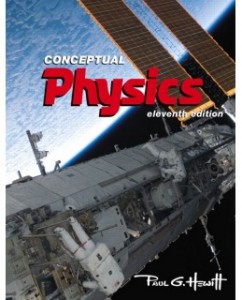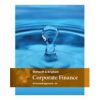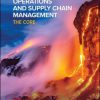Test Bank for Conceptual Physics, 11th Edition: Paul G. Hewitt
$35.00 Original price was: $35.00.$26.50Current price is: $26.50.
Test Bank for Conceptual Physics, 11th Edition: Paul G. Hewitt
This is completed downloadable of Test Bank for Conceptual Physics, 11th Edition: Paul G. Hewitt

Product Details:
- ISBN-10 : 0321568095
- ISBN-13 : 978-0321568090
- Author: Paul G. Hewitt
Since defining this course 30 years ago, Paul Hewitt’s best-selling book continues to be the benchmark book that two-thirds of professors use and by which all others are judged. In Conceptual Physics, Eleventh Edition Paul Hewitt shows how a compelling book and the most advanced media can be integrated to empower professors as they bring physics to life for non-science majors, both in and out of class. For the Eleventh Edition , Hewitt helps readers connect physics to their everyday experiences and the world around them, and provides additional help on solving mathematical problems.
Hewitt’s book is famous for engaging readers with analogies and imagery from real-world situations that build a strong conceptual understanding of physical principles ranging from classical mechanics to modern physics. With this strong foundation, readers are better equipped to understand the equations and formulas of physics, and are motivated to explore the thought-provoking exercises and fun projects in each chapter. The new edition features a fresh new design, content that is more focused on physics applications, and updated pedagogical features.
Table of Content:
Chapter 1: About Science Chapter 2: Atoms Part 1 Mechanics Chapter 3: Equilibrium and Linear Motion Chapter 4: Newton?s Laws of Motion Chapter 5: Momentum and Energy Chapter 6: Gravity, Projectiles, and Satellites Chapter 7: Fluid Mechanics Part 2 Heat Chapter 8: Temperature, Heat, and Thermodynamics Chapter 9: Heat Transfer and Change of Phase Part 3 Electricity and Magnetism Chapter 10: Static and Current Electricity Chapter 11: Magnetism and Electromagnetic Induction Part 4 Sound and Light Chapter 12: Waves and Sound Chapter 13: Light waves Chapter 14: Properties of Light Part 5 Atomic and Nuclear Physics Chapter 15: Quantum Theory Chapter 16: The Atomic Nucleus and Radioactivity Appendices Appendix A: On Measurement and Unit Conversion Appendix B: Linear and Rotational Motion Appendix C: Vectors Appendix D: Exponential Growth and Doubling Time Contents in Detail Chapter 1: About Science 1.1 Mathematics?The Language Of Science 1.2 Scientific Measurements 1.3 Scientific Methods 1.4 The Scientific Attitude Pseudoscience 1.5 Science, Art, And Religion 1.6 Science And Technology Risk Assessment 1.7 Physics?The Basic Science 1.8 In Perspective Chapter 2: Atoms 2.1 The Atomic Hypothesis 2.2 Characteristics Of Atoms 2.3 Atomic Imagery 2.4 Atomic Structure 2.5 The Elements 2.6 Periodic Table Of The Elements 2.7 Relative Sizes Of Atoms 2.8 Isotopes 2.9 Molecules 2.10 Antimatter 2.11 Dark Matter Part 1 Mechanics Chapter 3: Equilibrium and Linear Motion 3.1 Aristotle On Motion Aristotle (384-322 BC) 3.2 Galileo?s Concept Of Inertia Galileo Galilei (1564?1642) 3.3 Mass?A Measure Of Inertia One Kilogram Weighs 9.8 Newtons 3.4 Net Force Paul Hewitt Personal Essay 3.5 The Equilibrium Rule Practicing Physics 3.6 Support Force 3.7 Equilibrium Of Moving Things 3.8 The Force Of Friction 3.9 Speed And Velocity Speed Instantaneous Speed Average Speed Velocity Motion Is Relative 3.10 Acceleration Hang Time Chapter 4: Newton?s Laws of Motion 4.1 Newton?s First Law Of Motion The Moving Earth 4.2 Newton?s Second Law Of Motion Sample Problem Solving When Acceleration is g?Free Fall When Acceleration of Fall Is Less Than g?Non-Free Fall 4.3 Forces And Interactions 4.4 Newton?s Third Law Of Motion Simple Rule To Identify Action And Reaction Hands-On Physics [Box] Action And Reaction On Different Masses Defining Your System 4.5 Vectors Force Vectors Velocity Vectors Hands-On Vectors Practicing Physics Vector Components 4.6 Summary Of Newton?s Three Laws of Motion Newton biography Chapter 5: Momentum and Energy 5.1 Momentum 5.2 Impulse 5.3 Impulse Changes Momentum Case 1: Increasing Momentum Case 2: Decreasing Momentum Over a Long Time Case 3: Decreasing Momentum Over a Short Time Sample Problem Solving 5.4 Bouncing 5.5 Conservation Of Momentum Conservation Laws 5.6 Collisions 5.7 Energy 5.8 Work 5.9 Potential Energy 5.10 Kinetic Energy 5.11 Work-Energy Theorem Kinetic Energy and Momentum Compared 5.12 Conservation Of Energy 5.13 Power Sample Problem Solving 5.14 Machines 5.15 Efficiency 5.16 Sources Of Energy Junk Science Chapter 6: Gravity, Projectiles, and Satellites 6.1 The Universal Law of Gravity 6.2 The Universal Gravitational Constant, G 6.3 Gravity and Distance: The Inverse-Square Law 6.4 Weight and Weightlessness 6.5 Universal Gravitation 6.6 Projectile Motion Projectiles Launched Horizontally Sample Problem Solving Projectiles Launched at an Angle Practicing Physics? Hands-On Dangling Beads Hang Time Revisited 6.7 Fast-Moving Projectiles?Satellites 6.8 Circular Satellite Orbits 6.9 Elliptical Orbits 6.10 Energy Conservation and Satellite Motion 6.11 Escape Speed Chapter 7: Fluid Mechanics 7.1 Density 7.2 Pressure 7.3 Pressure in a Liquid 7.4 Buoyancy in a Liquid 7.5 Archimedes' Principle Archimedes And The Gold Crown Flotation Floating Mountains 7.6 Pressure in a Gas Boyle?s Law 7.7 Atmospheric Pressure Barometers 7.8 Pascal?s Principle 7.9 Buoyancy in a Gas 7.10 Bernoulli?s Principle Applications of Bernoulli?s Principle Part 2 Heat Chapter 8: Temperature, Heat, and Thermodynamics 8.1 Temperature 8.2 Absolute Zero 8.3 Internal Energy 8.4 Heat 8.5 Quantity Of Heat 8.6 The Laws Of Thermodynamics Order Tends to Disorder 8.7 Entropy 8.8 Specific Heat Capacity Sample Problem Solving The High Specific Heat Capacity of Water 8.9 Thermal Expansion Thermal Expansion Of Water Life At The Extremes Chapter 9: Heat Transfer and Change of Phase 9.1 Conduction 9.2 Convection 9.3 Radiation Emission of Radiant Energy Absorption of Radiant Energy Reflection of Radiant Energy 9.4 Newton?s Law of Cooling The Thermos Bottle 9.5 Global Warming and the Greenhouse Effect 9.6 Heat Transfer and Change of Phase Evaporation Condensation Condensation Crunch 9.7 Boiling 9.8 Melting and Freezing 9.9 Energy and Change of Phase Part 3 Electricity and Magnetism Chapter 10: Static and Current Electricity 10.1 Electric Force and Charge Electronics Technology and Sparks Conservation of Charge Ionized Bracelets: Science or Pseudoscience? 10.2 Coulomb?s Law Charge Polarization Microwave Oven 10.3 Electric Field 10.4 Electric Potential 10.5 Voltage Sources 10.6 Electric Current Direct Current and Alternating Current History of 110 Volts 10.7 Electric Resistance Superconductors 10.8 Ohm?s Law Sample Problem Solving Electric Shock Injury by Electric Shock 10.9 Electric Circuits Series Circuits Parallel Circuits Parallel Circuits and Overloading Safety Fuses 10.10 Electric Power Sample Problem Solving Electrical Energy and Technology Chapter 11: Magnetism and Electromagnetic Induction 11.1 Magnetic Poles 11.2 Magnetic Fields 11.3 Magnetic Domains 11.4 Electric Currents and Magnetic Fields Electromagnets Superconducting Electromagnets 11.5 Magnetic Forces on Moving Charges Magnetic Forces on Current-Carrying Wires Electric Meters Electric Motors 11.6 Electromagnetic Induction Faraday?s Law 11.7 Generators and Alternating Current 11.8 Power Production 11.9 The Transformer?Boosting or Lowering Voltage 11.10 Field Induction Part 4 Sound and Light Chapter 12: Waves and Sound 12.1 Vibrations and Waves 12.2 Wave Motion Wave Speed 12.3 Transverse and Longitudinal Waves 12.4 Sound Waves Speed of Sound 12.5 Reflection and Refraction of Sound 12.6 Forced Vibrations and Resonance 12.7 Interference Beats Standing Waves 12.8 Doppler Effect 12.9 Wave Barriers and Bow Waves 12.10 Shock Waves and the Sonic Boom 12.11 Musical Sounds Musical Instruments Chapter 13: Light waves 13.1 Electromagnetic Spectrum 13.2 Transparent and Opaque Materials 13.3 Color Selective Reflection Selective Transmission Mixing Colored Lights Complementary Colors Mixing Colored Pigments 13.4 Why the Sky is Blue, Sunsets are Red, and Clouds are White Why the Sky is Blue Why Sunsets are Red 2Why Clouds are White 13.5 Diffraction 13.6 Interference of Light Interference Colors by Reflection from Thin Films Chapter 14: Properties of Light 14.1 Reflection Law of Reflection Diffuse Reflection 14.2 Refraction 14.3 Dispersion Rainbows 14.4 Total Internal Reflection 14.4 Total Internal Reflection 14.5 Lenses Image Formation by a Lens Lens Defects? 14.6 Polarization Part 5 Atomic and Nuclear Physics Chapter 15: Quantum Theory 15.1 The Photoelectric Effect 15.2 Emission Spectra Emission Spectra Explained 15.3 Absorption Spectra 15.4 Fluorescence Fluorescent Lamps 15.5 Incandescence 15.6 Lasers 15.7 Wave-Particle Duality Double-Slit Experiment 15.8 Particles As Waves: Electron Diffraction Electron Waves 15.9 Quantum Mechanics 15.10 Uncertainty Principle 15.11 Correspondence Principle Complementarity Predictability And Chaos Chapter 16: The Atomic Nucleus and Radioactivity 16.1 Radioactivity 16.2 Alpha, Beta, and Gamma Rays 16.3 Environmental Radiation Units of Radiation Doses of Radiation Radioactive Tracers 16.4 The Atomic Nucleus and the Strong Force 16.5 Radioactive Half-Life 16.6 Transmutation of the Elements Natural Transmutation Artificial Transmutation 16.7 Radiometric Dating 16.8 Nuclear Fission Nuclear Fission Reactors Plutonium The Breeder Reactor 16.9 Mass-Energy Equivalence 16.10 Nuclear Fusion Controlling Fusion Appendices Appendix A: On Measurement and Unit Conversion United States Customary System Syst?me International Meter Kilogram Second Newton Joule Ampere Kelvin Area Volume Unit Conversion Appendix B: Linear and Rotational Motion Computing Velocity and Distance Traveled on an Inclined Plane Computing Distance When Acceleration is Constant Circular Motion Torque Angular Momentum Conservation of Angular Momentum Appendix C: Vectors Vectors and Scalars Adding Vectors Finding Components of Vectors Sailboats Appendix D: Exponential Growth and Doubling Time Glossary Photo Credits Index
People Also Search:
conceptual physics
conceptual physics 11th edition
conceptual physics 11th edition paul g hewitt
conceptual physics 11th edition download scribd
conceptual physics 11th edition testbank download pdf
Related products
Test Bank
Test Bank for Essentials of Business Law and the Legal Environment, 11th Edition: Richard A. Mann
Test Bank
Test Bank for Operating Systems: Internals and Design Principles, 7th Edition: William Stallings











